Kentucky Pest News Newsletter
HIGHLIGHTS IN THIS ISSUE
Number 1025__________June 14, 2004
TOBACCO
CORN
SOYBEAN
VEGETABLES
LAWN AND TURF
SHADE TREES AND ORNAMENTALS
DIAGNOSTIC LAB HIGHLIGHTS
IPM TRAP COUNTS

TOBACCO
CURRENT BLUE MOLD STATUS
By William Nesmith
 Situation:
Situation:
Blue mold has become well established along a general
southwest to northeast corridor-arc running from
Robertson County, Tennessee/Logan County, Kentucky in
the south, north to the Ohio River in Bracken County, Ky.
The further north along that arc, the more intense and
severe is the activity and damage, probably because the
cooler temperatures are favoring systemic development.
The only find located well away from that arc is that in
Union County, Tennessee, which is also located on a
connected but different corridor in a southeast to
northwest alignment with the southern-most outbreaks of
Logan County, Kentucky with Macon, Robertson, and
Union counties of Tennessee.
As of June 14, counties with one or more confirmed cases
included: in Kentucky - Logan, Hart, Green, Taylor, Adair,
Lincoln, Boyle, Garrard, Anderson, Mercer, Jessamine,
Fayette, Bourbon, Harrison, Mason, and Bracken counties;
and in Tennessee - Union, Macon, and Robertson counties.
Warnings exist for all counties with confirmed cases, plus
a watch exists for most of eastern and central Kentucky
and southern Ohio as most likely inoculum has moved
east and north from these initial outbreaks. The watch
extends west in Kentucky to a north-south line formed by
Daviess to Christian counties. So far, we have not found
evidence that the disease has moved very far away from
the main arc of current activity. Should cases be found
well away from the current activity, please contact me
immediately.
Most cases have involved setting infected transplants, with
foliar and systemic blue mold. However, agents are now
reporting finding newly developing lesions in early set
tobacco that was set with clean plants. Several agents are
reporting that serious damage has already occurred due to
the systemic development of blue mold.
I expect blue mold is much more prevalent than is being
reported, based on the strong activity occurring in
transplant sites that are known to have it and the disease-
conducive nature of the weather experienced during the
past month. Temperatures have been nearly ideal for
infections and sporulation in some areas, especially in
northern counties. Systemic development (veins, midribs,
buds, stems and roots) should also be occurring anywhere
the disease is present, considering the cool weather
experienced until recently, and this phase can be very
damaging. However, rains have been very frequent, which
may be washing spores out near the sources and reducing
long distance spread. Also, in some areas blue mold
lesions are being quickly colonized by bacteria and fungi,
resulting in a rapid rotting of the lesions, which may be
limiting spread, too. Target spot, anthracnose leaf spot,
frogeye leaf spot, angular leaf spot and bacterial soft rot
are often also present or even more prevalent in
transplants with blue mold, so be careful not to miss the
blue mold as it is the much bigger issue. Angular leaf spot
is very active in some counties and outbreaks of it often
precede blue mold epidemics, because it has a much
shorter life cycle.
Another complicating factor is that many transplants are
yellow, as they have been held under low fertility for
several weeks, making it difficult to discern a yellow lesion
(such as those of blue mold) on a yellow leaf. After such
plants are set and fertilization improves, overall plant
color will improve, and growers may find they have set
infected transplants. After new growth has had time to
develop in the field, systemically infected plants will
appear yellow and stunted compared to greener healthy
plants, and they are more likely to have soreshin, Pythium,
Fusarium stem rot, or black shank. Plants with partially
systemic activity sometimes grow off well, only to lodge
later in the season due to poor root systems. It is
important to find early field infections and take steps to
control them, as these fields can serve as the centers of
outbreaks later in the season. Once the canopy closes,
foliar blue mold can increase rapidly in the field and
control efforts are much less effective because coverage is
difficult.
Further laboratory assays conducted with samples from
Kentucky outbreaks indicate both mefenoxam/metalaxyl
resistant (insensitive) and sensitive populations are present
in the region. The sensitive portion of the populations can
be easily controlled with soil-directed applications of
Ridomil Gold or Ultra Flourish - consult labels for specific
directions. So far, we have found no evidence of resistance
to dimethomorph from the farms reporting failure of
Acrobat MZ to control the disease. In such cases, the poor
control is probably related to poor coverage, poor timing,
or loss of the fungicide with rain. Acrobat MZ must be
maintained at weekly intervals to maintain control.
Controls:
In Transplant Operations - Most of the crop has been set,
but attention is still needed for the remaining plants. Keep
fungicide sprays applied for good coverage and as often as
labels will allow. The labeled fungicides for use in
transplant systems can be found in the March 8, 2004 issue
of Kentucky Pest News.
[http://www.uky.edu/Agriculture/kpn/kpn04/pi040308.htm].
Remember our recommendations all season have
been: " Because tobacco transplant production systems are
so conducive to blue mold development, should even
small amounts of inoculum arrive, we recommend that all
tobacco transplant production systems should be managed
to minimize leaf wetness and regular preventive fungicide
sprays should be maintained. Once fungicide sprays have
been stopped the remaining transplants should be
destroyed to prevent the abandoned plants from serving
as an ideal staging area for blue mold."
In the field- Cultural practices that assist in blue mold
control include: using blue mold tolerant or resistant
varieties in conducive sites, setting blue mold-free
transplants, reducing plant populations, avoiding high
nitrogen rates, avoiding shade (especially from the south
and west), maintaining good air circulation in and around
the field, and destroying all unused transplants, promptly.
Foliar fungicide sprays can be very helpful in blue mold
management if applied regularly and well. Soil applied
Ridomil Gold or Ultra Flourish can also be very helpful
where mefenoxam-sensitive strains are operating.
Guidelines can be found in the April 26, 2004 issue of
Kentucky Pest News:
http://www.uky.edu/Agriculture/kpn/kpn04/pi040426.htm.
Information on tank-mixing Acrobat 50 WP and Dithane
DF Rainshield is presented in the June 1, 2004 issue;
http://www.uky.edu/Agriculture/kpn/kpn04/pn040601.htm#tobnew.
For the latest blue mold status and other tobacco disease information, check the KY Blue Mold Warning System online.
 http://www.uky.edu/Agriculture/kpn/kyblue/kyblue.htm
http://www.uky.edu/Agriculture/kpn/kyblue/kyblue.htm

For more information about tobacco pests, visit
"Insect Management Recommendations".
AGGRESSIVE ROOT ROT COMPLEX DEVELOPING IN TOBACCO
By William Nesmith
 An aggressive root rot complex is occurring widely in
some tobacco production areas of Kentucky, especially
those that have received frequent rains and temporary
flooding. The general appearance is consistent with black
shank, but other pathogens are involved, too. In fact, the
black shank pathogen is not involved in some fields, and
where it is, as often as not, it is a secondary pathogen
rather than the initial invader.
An aggressive root rot complex is occurring widely in
some tobacco production areas of Kentucky, especially
those that have received frequent rains and temporary
flooding. The general appearance is consistent with black
shank, but other pathogens are involved, too. In fact, the
black shank pathogen is not involved in some fields, and
where it is, as often as not, it is a secondary pathogen
rather than the initial invader.
Plants have often been set with active Pythium root rot or
Rhizoctonia root rot, which have moved into the stem,
severely stunting or killing the plant without help of other
pathogens. In others, the black shank pathogen is
invading directly into the base of the stem through routes
opened by Pythium, Rhizoctonia, and Fusarium (wilt and
basal stem rot). In still others the pathogens have moved
into the stem via a leaf covered in mud, with both Pythium
and Phytophthora (black shank pathogen) invading by this
route during wet weather. In some, systemic blue mold is
involved with soreshin (Rhizoctonia) or black shank
(Phytophthora) finishing-off the plants.
Pythium infections take on many different forms in
tobacco. This pathogen can cause a root rot, both in the
transplant beds as well as in the field, especially during
prolonged wet conditions. Sometimes, it attacks
transplants shortly after they are set in the field, causing a
soft stem rot, usually at the soil line. These field attacks
result in a soft, brown, watery rot that girdles the stem,
causing the plants to fall over, if the plant is vigorous with
a succulent stem. Plants attacked after stems harden may
not die quickly but turn yellow due to injury to the stem
and root system, with the pathogen slowly moving up the
outside of the stem in the more fleshy tissues. Some
Pythiums will move well up the stem, in a type of
"running stem canker". Invasions into the pith may also
occur, but much less frequently than with black shank. If
Pythium makes it to the pith, it often moves up one side
much more than the other, in contrast with black shank
where the pith is more uniformly colonized. However, in
fields where black shank is present, we often find black
shank moving in to make the final kill, "stealing Pythium's
catch".
Classic development of black shank is also occurring in
some fields, and especially with susceptible varieties and
under poor rotation and reduced fungicide programs.
Proper diagnosis of all these involve careful use of
incubation, culturing and microscopic techniques followed
by analysis of the findings before drawing a conclusion as
to which pathogen had the lead.
I urge growers to maintaining soil-directed fungicide
programs (preplant, cultivation, and layby) in fields with a
history of black shank or Pythium root rots. Our studies
have shown that Ridomil Gold and Ultra Flourish are
equally effective when used at equal rates of active
ingredient, so long as the strains of the pathogens involved
are sensitive to mefenoxam. The importance of cultivation
and layby applications have increased with use of
containerized transplants compared to traditional ground
plants. The reasons for this are not clear, but we suspect it
is because the media involved improves and prolongs the
habitat for these pathogen at the critical area at the base of
the plant and the amount of fleshy leaf/stem material
covered with soil serves as a food-base for these microbes.
Free water can be found in this zone much of the time in
plants having soilless media associated with the stem base,
thus favoring the more lethal shank-phase of black shank.
Therefore, efforts made to adjust nozzles to insure the
fungicide is directed under the plants and nearer the stem
should improve control. Most of the crop is still at a stage
where cultivation and layby treatments can be effectively
applied.


CORN
CORN INSECT UPDATE
By Ric Bessin
As the summer begins to heat up, so does the insect
pressure in corn. We are continuing to see a few insect
problems in corn. Much of the corn has progressed past
the stage for cutworm damage, although replanted corn
may still be vulnerable, as corn grows past the 18" stage it
is not attacks by cutworms. Until plants reach this stage,
corn should be scouted for cutworms at least twice a week.
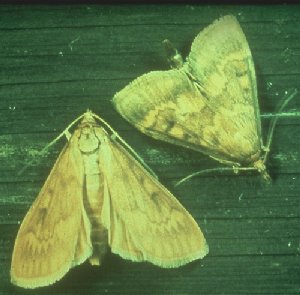 European corn borer moths are becoming active again for
the second generation. It is this generation that will attack
both corn and peppers. So pepper producers need to
European corn borer moths are becoming active again for
the second generation. It is this generation that will attack
both corn and peppers. So pepper producers need to
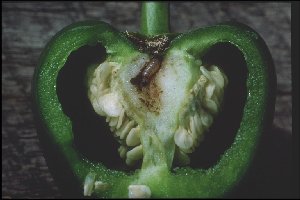 manage ECB in their plantings. Larvae of the first
generation of SWCB are active in corn. While the damage
is similar to that of ECB, we use a lower threshold of just
35% infested plants with larvae still in the whorls when
making treatment decisions. in July and August, the
second and possibly third generations of SWCB can cause
serious yield losses to late-planted, late-harvested corn.
manage ECB in their plantings. Larvae of the first
generation of SWCB are active in corn. While the damage
is similar to that of ECB, we use a lower threshold of just
35% infested plants with larvae still in the whorls when
making treatment decisions. in July and August, the
second and possibly third generations of SWCB can cause
serious yield losses to late-planted, late-harvested corn.
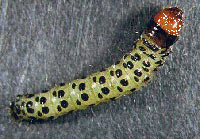
For more information about corn pests, visit
"Insect Management Recommendations".

CRAZY TOP
By Paul Vincelli
 The sustained wet weather of recent weeks led to some
flooding of corn fields, which raises concern about the risk
of crazy top. This disease is favored by flooding early in
crop development.
The sustained wet weather of recent weeks led to some
flooding of corn fields, which raises concern about the risk
of crazy top. This disease is favored by flooding early in
crop development.
Infection Process: Flooding of corn between emergence
and the 4-5 leaf stage for 24-48 hr allows swimming
zoospores of the crazy top fungus to enter the whorl and
infect the growing point of corn. If infection occurs, the
plant will produce numerous tillers, a leafy tassel ("crazy
top"), and no ears.
Occurrence: The fungus that causes crazy top occurs in
Kentucky and surrounding states, but it is not a
widespread problem. Since the early 1980's, we have
diagnosed only five cases in the state, and only one case
was anything approaching an economic level of loss. The
fungus also infects wheat, several turfgrasses, and certain
wild grasses, but is rarely important on other grass crops.
Current Outlook: Given that flooding has occurred early
in crop development in some corn fields, I do expect to
diagnose a few cases of crazy top this year. Most, if not all,
cases are likely to be minor. Serious economic loss from
crazy top is uncommon throughout the Midwest. It is
important to note that serious loss can happen. Indeed, it
may happen somewhere in Kentucky this year. However,
many times in the past Kentucky corn producers have
experienced serious flooding episodes of corn that would
have allowed crazy top infection, yet serious cases are
almost non-existent. This suggests that inoculum levels
are generally very low.


SOYBEAN
MANAGING THE SOYBEAN APHID IN 2004
By Doug Johnson
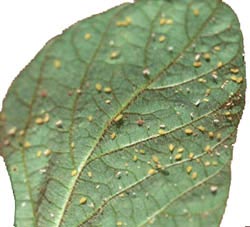 It is the season to begin thinking about management of
soybean aphids in our soybeans. Although we usually do
not see much activity until the end of June, it is the growth
stage of the plant that is the important indicator. Let's
review the situation, look at a management plan, and then,
if necessary, apply appropriate controls.
It is the season to begin thinking about management of
soybean aphids in our soybeans. Although we usually do
not see much activity until the end of June, it is the growth
stage of the plant that is the important indicator. Let's
review the situation, look at a management plan, and then,
if necessary, apply appropriate controls.
The soybean aphid has been in Kentucky since at least
2000. In those years the pest has been largely a curiosity
and hopefully, it will remain so.
Since first discovery of the insect we have conducted
informal surveys of where it has occurred. From this
information it is obvious that the pest can reach all of
Kentucky's soybean producing regions every year.
However, for the most part, the numbers of aphids remain
very low.
The generally low numbers are probably due to two
reasons. First, the soybean aphid can not over winter in
Kentucky. This pest has a complex biology, but part of its
needs is the presence of a specific plant on which to lay
over-wintering eggs. The common buckthorn (Rhamus
cathartica) is the most important host but there are at least
two other species that may also serve as over-wintering
hosts. These plants either do not occur in Kentucky or are
very rare. The result is soybean aphids must travel from
more northern areas (N. Illinois, Wisconsin and Michigan)
to get to us. Secondly, research in Wisconsin indicates that
the soybean aphid is a "cool" weather insect. It does best
at moderate temperatures. For example, the optimum
temperature for growth and reproduction is from 68-77 F.
At 86 F reproduction decreases by 60% and at 95 F the
aphids die.
The number of aphids in the 2004 crop depends, at least in
part, on how many aphids survived the winter. Winter
survival depends, in part, on how many aphids migrated
back to the over-wintering trees in the fall of 2003.
Observations by the research group at the Illinois Natural
History Survey indicate that the fall 2003 migration was
smaller than expected. Hopefully, this will result in fewer
aphids in 2004.
Early detection is of major importance with this pest.
Generally, in KY we need to start looking at the end of
June / beginning of July. However, it is the plant growth
stage, not the calendar date, that is important. Plants
should be examined beginning AT LEAST by the final
vegetative stage.
Late planted and/or double-crop plants are probably at
the greatest risk. Their reproductive stages occur later in
the season, which allows more time for the aphids to
migrate to Kentucky and become established.
Additionally, any plant stress, but especially drought
stress, increases the risk of yield loss at any particular
aphid population level. Check these fields first.
When you examine plants, check the whole plant. Though
aphids are most often found on the newest leaves, their
intolerance to heat will cause them to move about the
plant searching for the least stressful environment.
Aphid build-up generally occurs during the reproductive
stages. Current research indicates that aphid density
during the early reproductive stages (R1-R3) is definitely
related to yield loss. Plants in the R4, and later stages, can
tolerate greater aphid numbers, but just how many is a bit
of a guess and undoubtedly depends upon environmental
conditions. Current research may indicate why this is the
case. It appears that yield reduction is based on the
number of pods per plant. Seed weight and number of
seed per pod do not seem to be affected.
Research and experience has been used to develop a set of
action thresholds for soybean aphid. These thresholds
were developed by consensus of extension/research
entomologists working in the infested states. Though they
are likely to become more refined and robust as more
work is completed, they are certainly serviceable at this
point. However, many questions remain to be answered.
At present it is suggested that insecticidal control be
applied if soybean aphid populations are: 1.) increasing
and 2.) reach the level of 250 aphids per plant during
growth stages R1 through R4. At R5 - R6, levels would
need to be between 800 and 1000 aphids per plant. After
R6, data indicates that nothing is gained by applying
control.
It is important not to "pull the trigger" too soon. Many
predators and parasitoids feed on these aphids, keeping
their populations low. Application of insecticide removes
this "Natural Control" but will not control all the aphids.
Those that live have a predator free environment in which
to feed and reproduce.
In the unlikely event that insecticidal control is warranted,
producers will have several products from which to
choose. The synthetic pyrethroid products - Asana XL
(esfenvalerate), Fury (zeta-cypermethrin), Mustang Max
(zeta-cypermethrin), Warrior
(lambda-cyhalothrin) and the organophosphate products -
Lorsban (chlorpyrifos) and Penncap-M (methyl parathion)
currently have federal labels.
In Kentucky marketers of two additional products have
issued 2(ee) recommendations. They are for Baythroid 2
(cyfluthrin), a synthetic pyrethroid, and Chlorpyrifos
(chlorpyrifos), an organophosphate, that can be used
within the state. If you choose to use one of these products
make sure you have a copy of the 2(ee) recommendation
sheet.
Regional research has shown that good return on
investment can be made if insecticides are used in a timely
manner when the appropriate populations of aphids are
present. As timing (plant stage) changes and population
size decreases from the recommended numbers, likelihood
and size of return on control cost decreases.
Review
Status in 2004.
- The soybean aphid was first discovered in KY in 2000
and has been seen all subsequent years.
- The soybean aphid can be found in the complete KY
production region every year.
- Generally aphid numbers remain low.
- Soybean aphid can not over-winter in KY. They must
migrate to KY each year.
- Soybean aphid does not appear to be well adapted to hot
temperatures.
- Fall 2003 migration to over-wintering hosts was reduced.
Hopefully, this will result in fewer aphids in 2004.
Management
- Early detection is important. Begin examining plants AT
LEAST by the final vegetative stage. Generally, about
the end of June is a good time to start.
- Late planted / or double crop beans are at greater risk
than early planted plants.
- Drought stress increases risk of yield loss.
- When checking plants, check the whole plant.
- Protecting plants during the R1 to R3 stages is the most
important time.
- Plants in the R4-R6 stages can tolerate more aphids.
- After R6 it is unlikely that controlling aphids has any
impact on the yield.
- Thresholds have been developed by entomologists
across the soybean infested states.
- With an actively increasing population of soybean
aphid, use an action threshold of 250 aphids per plant at
R1 through R4 and 1000 aphids per plant from R4
through R5. This threshold incorporates an approximate
7-day lead-time between scouting and treatment. After
R6 no control is warranted.
- Do NOT apply insecticides too early. You may end up
with more aphids than you had!!
Insecticidal Control
- Several insecticides are available for use if needed. See
INSECT MANAGEMENT RECOMMENDATIONS FOR
FIELD CROPS AND LIVESTOCK at:
http://www.uky.edu/Agriculture/PAT/recs/rechome.
htm
- Print copies are available at your County Extension
office
For more information about soybean pests, visit
"Insect Management Recommendations".

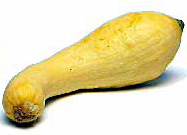
VEGETABLES
CUCUMBER BEETLES
By Ric Bessin
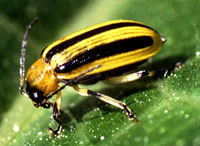
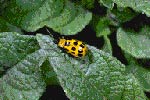 Melon, cucumber, pumpkin, and squash growers need to
monitor their plantings for striped and spotted cucumber
beetles. While many growers are using at-planting,
systemic insecticides to control cucumber beetles and the
disease they transmit, Bacterial Wilt, these treatments only
last from three to five weeks. Higher rates provide longer
periods of control. Growers need to continue to monitor
for the beetles and use a threshold of one beetle per plant
to base re-treatment decisions. Many growers have found
that low rates of the at-planting treatments combined with
as-needed rescue treatments have been effective control
strategies for these pests
Melon, cucumber, pumpkin, and squash growers need to
monitor their plantings for striped and spotted cucumber
beetles. While many growers are using at-planting,
systemic insecticides to control cucumber beetles and the
disease they transmit, Bacterial Wilt, these treatments only
last from three to five weeks. Higher rates provide longer
periods of control. Growers need to continue to monitor
for the beetles and use a threshold of one beetle per plant
to base re-treatment decisions. Many growers have found
that low rates of the at-planting treatments combined with
as-needed rescue treatments have been effective control
strategies for these pests


LAWN & TURF
JAPANESE BEETLES AND MASKED CHAFERS ARE FLYING
By Mike Potter and Dan Potter
 Adult Japanese beetles and masked chafers have begun to
emerge. As is usually the case, it is difficult to predict how
serious a problem these pests will be this year. Both
Japanese beetles and masked chafers lay eggs in moist soil
under turf. Their grubs then feed on turfgrass roots.
Adult Japanese beetles and masked chafers have begun to
emerge. As is usually the case, it is difficult to predict how
serious a problem these pests will be this year. Both
Japanese beetles and masked chafers lay eggs in moist soil
under turf. Their grubs then feed on turfgrass roots.
Japanese Beetles (Adults) - Detailed information on this
pest can be found in ENT-5, Japanese Beetles in the Urban
Landscape. Options for protecting landscape plants from
foliage feeding adults are as follows:
Plant Selection- The best way to avoid perennial battles
with adult Japanese beetles is to select plant material that
is less preferred. Publication ENT-5 lists species and
cultivars of trees and shrubs that are less likely to be
attacked by beetles.
Hand Picking and Exclusion- For smaller plants, it may be
practical simply to remove the beetles by hand. Volatile
odors released from beetle-damaged leaves attract more
beetles. By not allowing Japanese beetles to accumulate,
plants will be less attractive to other beetles. One of the
easiest ways to remove beetles from small plants is to
shake them off early in the morning when the insects are
sluggish. The beetles may be killed by shaking them into a
bucket of soapy water. Highly valued plants such as roses
can be protected by covering them with cheesecloth or
other fine netting during peak beetle activity (usually late
June to mid-July).
Insecticides- Insecticide products containing the active
ingredients bifenthrin (e.g. TalstarOne), cabaryl (e.g.
Sevin), cyfluthrin (e.g. Tempo, Bayer Advanced Lawn&
Garden Multi-Insect Killer), deltamethrin (e.g.
Deltaguard), lambda cyhalothrin (e.g. Scimitar,
Spectracide Triazicide), or permethrin are labeled for
control of adult Japanese beetles. Foliage and flowers
should be thoroughly treated. The application may need to
be repeated at 7-10 day intervals to prevent re-infestation
during the adult flight period, or if it rains before the
residues have dried. Follow label directions and avoid
spraying under windy conditions. Insecticidal soaps or
pyrethrum may kill beetles that are hit by the spray, but
they provide no residual protection. Products containing
the botanical insecticide neem (azadirachtin) provide some
deterrence of Japanese beetle feeding.
White Grubs - There is no reliable way to predict whether
any given year will be a bad one for white grubs - the
immature, turf-feeding stages of Japanese beetles, masked
chafers, and certain other beetles. Moreover, since grub
infestations tend to be localized and sporadic, only a small
percentage (< 10 percent) of Kentucky lawns require
treatment, even in bad years for grubs.
Indicators of Infestation- White grubs and their resultant
damage are not usually evident until August or
September. Although sampling the turf is the only way to
confirm that grubs are present, certain factors may indicate
an increased risk of infestation later in the season. If your
turf has a history of serious grub problems, there is a
greater chance that adult beetles will return and re-infest
the same areas. Sites with large numbers of adult beetles in
June and July are more likely to have grubs in late
summer. Early warning signs include swarms of brown,
˝-inch long masked chafer beetles skimming over the turf
at dusk, or green June beetles buzz-bombing the turf by
day in search of mates and egg-laying sites. Masked chafer
and May beetle adults are also attracted to porch and
streetlights at night. Heavy infestations of adult Japanese
beetles feeding in the area might also foretell subsequent
problems with grubs of that species.
Rainfall and soil moisture are critical factors affecting the
extent of grub damage during a season. Frequent irrigation
in June and July may attract egg-laying female beetles to
the turf, especially if surrounding areas are dry. High soil
moisture also increases egg survival. If lawns are irrigated
during periods of dryness in June and July, be especially
alert for signs of grubs later in the summer. Conversely,
adequate soil moisture in August and September (when
grubs are actively feeding) can help to hide root injury.
Irrigated turf can sometimes tolerate 20 or more grubs per
square foot before showing signs of injury.
Treatment Strategies - Two different strategies are available
for controlling white grubs with insecticides: preventive
and curative. Each approach has its own merits and
limitations. With preventive control, the insecticide is
applied as insurance, before a potential grub problem
develops. Consequently, preventive control is best suited
for high-risk sites with a history of grub problems, or turf
sites where heavy beetle activity is noted.
Preventive control requires the use of insecticides with
long residual activity in soil. Look for products containing
the active ingredient imidacloprid (e.g. Merit®, Bayer
Advanced™ Season-Long Grub Control) or halofenozide
(e.g. Mach 2®). Both of those ingredients have sufficient
soil persistence to be applied any time from early June to
mid-July and still control young grubs hatching from eggs
from mid-July to early August. The optimum treatment
period for these products is mid-June to mid-July.
Preventive treatments afford greater flexibility in
application timing, and are easier to schedule and
implement than are curative treatments. They often afford
greater peace of mind to golf superintendents and lawn
service companies because potential damage is avoided or
minimized. The main drawback of preventive grub
control is that the decision to treat must be made before
knowing the extent of infestation. Grub outbreaks tend to
be localized and sporadic and only a small percentage of
lawns require treatment in a given year. Thus, preventive
control often results in areas being treated unnecessarily.
Good record keeping and observation will help in
pinpointing grub-prone areas, which are the most logical
candidates for preventive applications.
With curative control, treatment is applied in late summer
- typically August or September - after the eggs have
hatched and grubs are present. Ideally, the decision to
treat is based on site inspection and sampling or past
history of infestation. Since white grub infestations tend to
be localized, the entire lawn often will not need to be
treated. Grub "hot spots," which can be confirmed by
sampling, are most likely to be full sun, south or west-
facing slopes, lawns seeded with Kentucky bluegrass,
lawns that were heavily irrigated during June and July,
and turf areas that were damaged by grubs in previous
years.
Proper timing of curative grub treatments can be tricky.
Insecticides applied before early August may degrade
before the eggs have hatched, whereas if the product is
applied in late August or September, the grubs will be
large and harder to kill and severe damage to turf may
have already occurred. Granular formulations containing
the active ingredient trichlorfon (e.g. Dylox, Bayer
Advanced 24-hour Grub Control) are the fastest-acting,
most effective insecticides for curative grub control. There
is little benefit in applying a short-lived, curative-type product
for white grubs in June or July.


SHADE TREES AND ORNAMENTALS
MULCHES, MUSHROOMS AND MOLDS
By John Hartman
 Recent rains and use of fresh wood chip or bark mulch in
Kentucky landscape beds has resulted in a proliferation of
nuisance fungi growing in the mulch. One that is
prevalent now is slime mold which produces yellow or
whitish patches of mold (sometimes referred to as "dog
vomit fungus") over the surface of the landscape mulch.
Although the nuisance fungi rarely harm plants, some
homeowners and landscapers object to their appearance
and thus seek ways to prevent or eliminate these fungi.
Recent rains and use of fresh wood chip or bark mulch in
Kentucky landscape beds has resulted in a proliferation of
nuisance fungi growing in the mulch. One that is
prevalent now is slime mold which produces yellow or
whitish patches of mold (sometimes referred to as "dog
vomit fungus") over the surface of the landscape mulch.
Although the nuisance fungi rarely harm plants, some
homeowners and landscapers object to their appearance
and thus seek ways to prevent or eliminate these fungi.
Mulches are used in Kentucky gardens and landscapes for
many reasons. By suppressing vegetation near trees and
shrubs, they keep mowers and string trimmers from
damaging the bark. In landscape beds and in the garden,
they control weeds, improve drainage, prevent soil water
loss, lower soil temperatures, prevent soil erosion and, as
they decompose they release minerals and leave behind
humus which benefits the plants. Organic mulches
generally suppress plant pathogenic fungi and enhance
beneficial mycorrizal fungi. For continuing benefits,
mulches need to be reapplied periodically.
There are many examples of fungi that grow on or from
landscape mulch. Examples include stinkhorns (Mutinus
and other related species), bird's nest fungus
(Crucibularium), earth stars (Geastrum spp), assorted
toadstools, slime molds (Physarum and other species), and
the shotgun, or artillery fungus (Sphaerobolus). Of these,
only the shotgun fungus is truly a nuisance because it
shoots tiny black spore masses onto nearby surfaces such
as home siding and cars. Fungi also permeate thick layers
of dry mulch, creating a hydrophobic mulch which is not
easily penetrated by water, thus causing irrigation
problems. Fertility problems can result when the fungi
decomposing mulch remove from the soil, nitrogen
needed by the plants.
Can mulches transmit plant diseases? The fungi that cause
Verticillium wilt and Phytophthora root rot can be carried
in fresh mulch, but would not be a problem in composted
mulch. Similarly, although the Rhizoctonia root rot fungus
can use mulch as a food base before causing damping-off
of seedling plants, it can be destroyed by six weeks of
composting where mulch reaches 130-160 degrees F. Most
organic mulches do not contain plant pathogens.
Beneficial mycorrhizal fungi are active in shallow (1-2")
layers of mulch, but are inhibited by deep mulch layers (4-
6").
With proper manipulation, mulches can be prevented
from developing nuisance fungi while maintaining the
benefits of mulch. Much work on microbes and mulch has
been done at Ohio State University where they have found
that hardwood mulches (commonly used in Kentucky),
especially if finely ground, contain a large amount of
cellulose which decomposes fairly rapidly and leads to
nuisance fungi. Such mulches, if composted for a few
weeks with added nitrogen, and maintained at moisture
levels over 40% will not develop nuisance fungi. Such
moisture levels allow bacteria and other fungi to compete
with the nuisance molds. Wet mulches are heavy and
require more effort to transport, however moisture
contents of organic products up to 50% will not present
excessive transport weight problems.
The following are suggestions for the landscape industry
and for homeowners wishing to avoid nuisance fungi:
- Purchase composted mulch products.
- Use mulches low in wood and high in bark.
- Avoid finely ground woody products unless composted
first.
- If using fresh wood chips such as those from a tree
maintenance firm, add water to the mulch and allow
the pile to partially compost for six weeks. If the wood
chips do not include fresh leaves, add some nitrogen to
speed composting.
- Use coarse mulches, but do not apply them too deep.
- Soak all mulches with water immediately after
application to enhance bacterial colonization.
- Do not apply mulch deeper than two inches.
- Do not use sour mulches (highly acidic mulches giving
off an acrid odor) because they injure plants.
WHAT'S EATING MY MAGNOLIA?
By Mike Potter
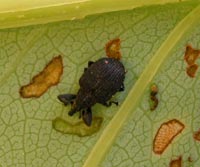 Clients this week have been finding small weevil-shaped
bugs on their magnolias, accompanied by numerous rice-
shaped holes. The culprit is the magnolia weevil, also
known as the yellow poplar or sassafras weevil. The black,
1/8th -inch long beetles are sometimes mistaken for ticks
and 'play dead' when handled. They do not bite.
Clients this week have been finding small weevil-shaped
bugs on their magnolias, accompanied by numerous rice-
shaped holes. The culprit is the magnolia weevil, also
known as the yellow poplar or sassafras weevil. The black,
1/8th -inch long beetles are sometimes mistaken for ticks
and 'play dead' when handled. They do not bite.
Magnolia weevils over-winter as adults and lay eggs the
following spring in newly expanding leaves. After egg
hatch, the larvae mine the leaves producing a brownish,
blotchy area. The weevils and damage observed now are
from the subsequent (second) adult generation, which
chews small crescent-shaped holes in the leaves of
magnolia, tulip poplar, and sassafras. Damage appears
most severe on magnolias (southern, sweet bay, etc.) that
hold their leaves year-round. The injury does not seriously
harm the tree, but the leaf holes are concerning and
cosmetically unappealing to some clients.
Control of the leaf-chewing adults can be accomplished by
spraying the foliage with Sevin or any pyrethroid
insecticide (Talstar, Tempo (= Bayer Advanced Multi
Insect Killer), Scimitar (= Spectracide Triazicide, etc.).
Thorough spray coverage on upper and lower leaf surfaces
is essential



DIAGNOSTIC LAB HIGHLIGHTS
DIAGNOSTIC LAB - HIGHLIGHTS
By Julie Beale and Paul Bachi
During the past week, we have diagnosed samples of
herbicide injury, Fusarium root rot, and magnesium
deficiency on corn; Lepto leaf spot on alfalfa; blue mold,
target spot, angular leaf spot, tomato spotted wilt virus,
black shank, Pythium root rot and manganese toxicity on
tobacco.
On fruits and vegetables, we have seen Septoria leaf spot
on blackberry; black rot on grape; Mycosphaerella leaf
spot on strawberry; frogeye leaf spot and fire blight on
apple; angular leaf spot (Isariopsis) on bean; Phytophthora
blight and bacterial leaf spot on pepper; Septoria leaf spot,
southern blight, tomato spotted wilt virus, and Pythium
root rot on tomato; and yellow vine decline on zucchini.
On ornamentals, we have seen leaf/flower gall
(Exobasidium) on azalea; Pythium root rot on daylily; rust
on rose; Entomosporium leaf spot on photinia;
Coccomyces leaf spot on serviceberry; manganese toxicity
on ornamental pear; spot anthracnose and powdery
mildew on dogwood; and anthracnose on oak.


IPM TRAP COUNTS:
By Patty Lucas, University of Kentucky Research Center
UKREC-Princeton, KY, June 4 - 11, 2004
| Black Cutworm
| 16
|
| True Armyworm
| 2
|
| Corn Earworm
| 14
|
| European Corn Borer
| 1
|
| Southwestern Corn Borer
| 8
|
|
To view trap counts for Fulton County, Kentucky
go to - http://ces.ca.uky.edu/fulton/anr/
and click on "Insect Trap Counts".
For information on trap counts in southern Illinois visit the
Hines Report at -
http://www.ipm.uiuc.edu/pubs/hines_report/index.html.
The Hines Report is posted weekly by Ron Hines, Senior
Research Specialist, at the University of Illinois Dixon
Springs Agricultural Center
NOTE: Trade names are used to simplify the information presented in
this newsletter. No endorsement by the Cooperative Extension Service
is intended, nor is criticism implied of similar products that are not
named.
Lee Townsend
Extension Entomologist
BACK
TO KY PEST NEWS HOME
 Situation:
Situation:


 European corn borer moths are becoming active again for
the second generation. It is this generation that will attack
both corn and peppers. So pepper producers need to
European corn borer moths are becoming active again for
the second generation. It is this generation that will attack
both corn and peppers. So pepper producers need to
 manage ECB in their plantings. Larvae of the first
generation of SWCB are active in corn. While the damage
is similar to that of ECB, we use a lower threshold of just
35% infested plants with larvae still in the whorls when
making treatment decisions. in July and August, the
second and possibly third generations of SWCB can cause
serious yield losses to late-planted, late-harvested corn.
manage ECB in their plantings. Larvae of the first
generation of SWCB are active in corn. While the damage
is similar to that of ECB, we use a lower threshold of just
35% infested plants with larvae still in the whorls when
making treatment decisions. in July and August, the
second and possibly third generations of SWCB can cause
serious yield losses to late-planted, late-harvested corn.

 The sustained wet weather of recent weeks led to some
flooding of corn fields, which raises concern about the risk
of crazy top. This disease is favored by flooding early in
crop development.
The sustained wet weather of recent weeks led to some
flooding of corn fields, which raises concern about the risk
of crazy top. This disease is favored by flooding early in
crop development.

 It is the season to begin thinking about management of
soybean aphids in our soybeans. Although we usually do
not see much activity until the end of June, it is the growth
stage of the plant that is the important indicator. Let's
review the situation, look at a management plan, and then,
if necessary, apply appropriate controls.
It is the season to begin thinking about management of
soybean aphids in our soybeans. Although we usually do
not see much activity until the end of June, it is the growth
stage of the plant that is the important indicator. Let's
review the situation, look at a management plan, and then,
if necessary, apply appropriate controls.


 Melon, cucumber, pumpkin, and squash growers need to
monitor their plantings for striped and spotted cucumber
beetles. While many growers are using at-planting,
systemic insecticides to control cucumber beetles and the
disease they transmit, Bacterial Wilt, these treatments only
last from three to five weeks. Higher rates provide longer
periods of control. Growers need to continue to monitor
for the beetles and use a threshold of one beetle per plant
to base re-treatment decisions. Many growers have found
that low rates of the at-planting treatments combined with
as-needed rescue treatments have been effective control
strategies for these pests
Melon, cucumber, pumpkin, and squash growers need to
monitor their plantings for striped and spotted cucumber
beetles. While many growers are using at-planting,
systemic insecticides to control cucumber beetles and the
disease they transmit, Bacterial Wilt, these treatments only
last from three to five weeks. Higher rates provide longer
periods of control. Growers need to continue to monitor
for the beetles and use a threshold of one beetle per plant
to base re-treatment decisions. Many growers have found
that low rates of the at-planting treatments combined with
as-needed rescue treatments have been effective control
strategies for these pests

 Adult Japanese beetles and masked chafers have begun to
emerge. As is usually the case, it is difficult to predict how
serious a problem these pests will be this year. Both
Japanese beetles and masked chafers lay eggs in moist soil
under turf. Their grubs then feed on turfgrass roots.
Adult Japanese beetles and masked chafers have begun to
emerge. As is usually the case, it is difficult to predict how
serious a problem these pests will be this year. Both
Japanese beetles and masked chafers lay eggs in moist soil
under turf. Their grubs then feed on turfgrass roots.

 Clients this week have been finding small weevil-shaped
bugs on their magnolias, accompanied by numerous rice-
shaped holes. The culprit is the magnolia weevil, also
known as the yellow poplar or sassafras weevil. The black,
1/8th -inch long beetles are sometimes mistaken for ticks
and 'play dead' when handled. They do not bite.
Clients this week have been finding small weevil-shaped
bugs on their magnolias, accompanied by numerous rice-
shaped holes. The culprit is the magnolia weevil, also
known as the yellow poplar or sassafras weevil. The black,
1/8th -inch long beetles are sometimes mistaken for ticks
and 'play dead' when handled. They do not bite.

